Email Marketing
Is Email Marketing Inbound or Outbound
Curious about whether email marketing is inbound or outbound? Discover the nuances and practical implications to gain a deeper understanding.

Email marketing serves as a flexible instrument that can function as either an inbound or outbound technique, based on the strategy and objectives of the campaign. Grasping the differences between these approaches is essential for devising a successful email marketing plan.
While some may argue that it's a clear-cut case, the truth is, the lines can often blur. So, how do we determine whether email marketing belongs in the inbound or outbound category?
Let's explore the nuances and practical implications of each approach to gain a deeper understanding of how email marketing fits into the broader spectrum of marketing strategies.
Key Takeaways
- Inbound email marketing focuses on nurturing consumer interest and building brand trust through tailored content.
- Outbound email marketing requires a strategic and targeted approach to directly connect with potential customers and yield impressive results.
- Audience engagement in email marketing can be enhanced through segmentation, personalization, and two-way communication.
- Balancing the reach and speed advantages of inbound and outbound strategies can optimize email marketing efforts.
Defining Email Marketing
Email marketing effectively nurtures initial consumer interest and drives brand awareness through relevant and engaging content. By leveraging the power of inbound email marketing, we can attract and engage our audience with tailored, valuable content that speaks directly to their needs and interests. This targeted approach not only increases opt-ins and brand trust but also saves money by maximizing return on investment (ROI) through personalized communication.
Inbound email marketing is a strategic tool for nurturing consumer interest and building brand awareness organically. By delivering valuable content directly to our customers' inboxes, we can establish our brand as a trusted source of information and solutions. This approach is particularly effective for products and services with longer sales cycles, as it requires a long-term commitment to engaging and nurturing our audience.
Inbound Marketing Overview
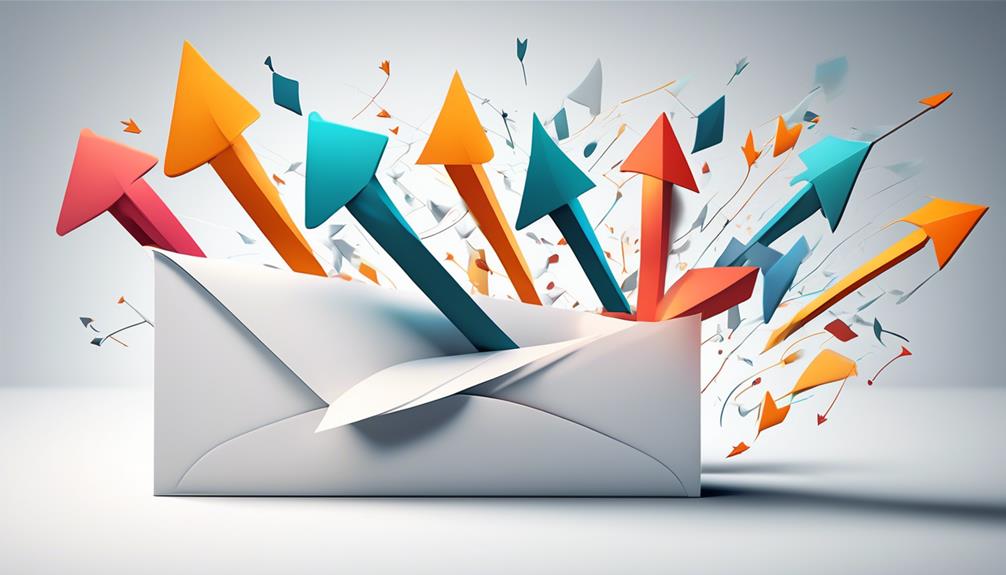
Inbound marketing is a critical component of any successful email marketing strategy. By focusing on providing valuable and relevant content to consumers, we can nurture their interest and drive brand awareness organically.
This approach not only saves money and maximizes ROI but also fosters a sense of trust and loyalty with our audience, setting the stage for long-term success.
Inbound Marketing Principles
Utilizing a customer-centric approach, inbound marketing principles focus on nurturing consumer interest through relevant and engaging content, ultimately attracting consumers to products and services while building brand trust and loyalty.
Inbound email marketing strategies aim to provide valuable content that resonates with the target audience, leading to increased lead generation and improved engagement. By creating content that addresses the needs and pain points of potential customers, businesses can reach their potential audience more effectively.
This approach not only saves money by tailoring marketing efforts to consumer interest but also maximizes return on investment (ROI) by driving organic brand awareness and loyalty.
Inbound marketing principles are particularly effective for products and services with longer sales cycles, requiring a long-term commitment to building relationships and delivering valuable content.
Email as Inbound Strategy
Drawing consumers in with valuable and relevant content, inbound email marketing strategically nurtures initial interest and engagement with your brand. This approach provides tailored content to attract and retain potential customers, increasing brand trust and loyalty.
Additionally, inbound email marketing saves costs by focusing on consumer interests, maximizing return on investment. By nurturing a loyal and engaged audience over time, it drives organic brand awareness and growth.
In contrast to outbound email marketing, which often incurs higher costs and can be seen as intrusive, inbound email marketing increases opt-ins and protects the reputation of your IP address.
Leveraging the capabilities of email marketing platforms, inbound email strategies capitalize on delivering the right content to the right audience, at the right time, for maximum impact.
Outbound Marketing Overview
When implementing outbound email marketing, a strategic and targeted approach is essential to effectively reach potential customers and drive results. Outbound email marketing serves as a direct marketing channel, allowing businesses to rapidly reach and engage with target audiences. By leveraging the speed of outbound email, companies can promptly connect with potential customers, delivering messages on their own schedule.
Although outbound marketing may carry the risk of appearing as spam, careful management and adherence to best practices can mitigate this concern. This proactive approach to reaching potential customers doesn't require consent, as emails are sent based on an ideal customer profile. When executed well, outbound email campaigns can yield impressive results, with open rates averaging at 16.07% and click-through rates at 3.29%. These statistics underscore the potential of effective email outreach in driving customer engagement and conversions.
Therefore, when considering outbound marketing strategies, it's crucial to craft compelling, targeted messages that resonate with the intended audience to maximize the impact of each campaign.
Email Marketing Strategies

Crafting compelling email marketing strategies is crucial for businesses to effectively reach potential customers and drive results, especially considering the potential impact of outbound email campaigns on customer engagement and conversions.
Here are three key strategies to consider:
- Personalization: Tailoring emails based on consumer interests and behaviors can significantly increase engagement and conversion rates. Using data to personalize content and offers can make the recipient feel valued and understood, leading to higher sales potential.
- Automation: Implementing automated email workflows can streamline the nurturing process, ensuring that leads are consistently engaged with relevant content. This strategy can help businesses save time and resources while maintaining a consistent presence in the consumer's journey.
- Segmentation: Dividing the email list into different segments based on demographics, behaviors, or past interactions allows for targeted and relevant communication. By sending content that aligns with the recipient's interests, businesses can improve the chances of driving sales and increasing customer satisfaction.
Key Differences
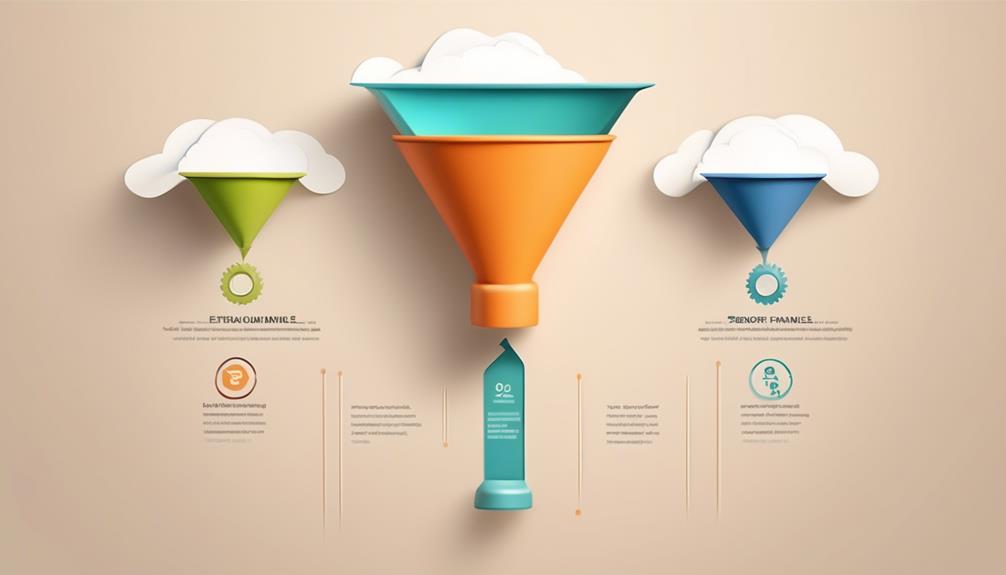
To understand the distinction between inbound and outbound email marketing, it's essential to recognize their fundamental disparities in approach and impact.
Inbound email marketing focuses on attracting interested consumers through personalized, tailored content. It involves two-way communication, building a loyal audience over time through engagement.
In contrast, outbound email marketing pushes emails to a wider audience, often using non-personalized, mass-mailed content. It's a one-way communication strategy that aims for immediate results.
The key difference lies in the audience's interest and engagement level. Inbound marketing targets a smaller, more engaged audience, fostering long-term loyalty, while outbound marketing emails target a larger but less interested audience, resulting in immediate, albeit potentially less enduring, outcomes.
Moreover, inbound email marketing involves building and nurturing email lists organically, often through content offerings and opt-ins, ensuring that the audience has a genuine interest in the content they receive.
On the other hand, outbound email marketing often involves purchased or rented email lists, leading to a less targeted and less engaged audience.
Understanding these differences is crucial in crafting effective email marketing strategies that align with business goals and audience preferences.
Audience Engagement

Understanding the pivotal role of audience engagement in email marketing, we can now explore strategies to foster meaningful interactions and drive impactful results.
- Personalized Content: Tailoring email content to the preferences and behaviors of the audience is crucial. Utilizing segmentation and personalization techniques can significantly enhance audience engagement. By crafting content that resonates with the target audience, we can encourage interaction and increase the likelihood of meaningful engagement.
- Encouraging Interaction: It's essential to encourage feedback, replies, and social media sharing to gauge and improve audience engagement with email content. Creating opportunities for two-way communication can strengthen the connection between the brand and the audience, leading to increased engagement and brand loyalty.
- Monitoring and Optimization: Regularly monitoring metrics such as open rates, click-through rates, and conversion rates provides insights into the effectiveness of audience engagement strategies. This data-driven approach allows for continual optimization of email content and strategies to maximize engagement and drive impactful results.
Reach and Speed

When it comes to email marketing, reach and speed are crucial for expanding our audience and delivering messages swiftly.
By rapidly growing our email list and effectively distributing messages, we can efficiently extend our marketing reach and promptly engage with a broader audience through email communications.
Achieving a wider reach and delivering messages at a faster pace are essential for connecting with a larger audience and ensuring prompt delivery of marketing messages through email.
Email Reach Advantage
Email marketing's reach advantage and speed are critical factors in determining the effectiveness of both inbound and outbound strategies.
- Inbound Email Marketing: It takes time to attract an interested audience and build a loyal subscriber base, leading to a higher ROI over months or years.
- Outbound Email Marketing: Reaches a larger audience more quickly, expediting message delivery to potential customers.
- Cost-Effectiveness: Inbound marketing targets warm leads and personalized content for a smaller list, making it cost-effective with higher ROI. Outbound marketing involves higher costs due to larger contact lists and email volumes, resulting in lower ROI.
Email marketing's reach advantage can be leveraged by choosing the right email service provider, ensuring effective message delivery and maximizing the potential of both inbound and outbound strategies.
Email Speed Benefits
Leveraging the reach advantage of email marketing, we can now explore the impactful speed benefits of both inbound and outbound strategies.
Outbound email marketing targets a wider audience in a shorter period, making it ideal for industries with shorter sales cycles. This approach can lead to quicker results but may also incur increased costs.
On the other hand, inbound email marketing, while taking more time to attract an interested audience, has lower costs and a higher return on investment with targeted warm leads from existing subscribers.
Understanding the email speed benefits of both inbound and outbound strategies is crucial for optimizing marketing efforts. By strategically balancing the speed and reach advantages of each approach, businesses can effectively engage with their audience and achieve their marketing goals.
Inbound Vs Outbound Emails
To effectively compare inbound and outbound emails, we must consider their respective reach and speed to determine the most strategic approach for our email marketing efforts.
- Reach: Inbound emails attract an interested audience over time, nurturing a loyal following. On the other hand, outbound emails reach a wider audience more quickly, generating immediate results.
- Speed: Outbound emails have a quicker impact, making them suitable for short-term campaigns. In contrast, inbound emails take time to build an interested audience but are 61% cheaper than outbound emails.
Considering these factors, a balanced approach is crucial. Utilize outbound emails for immediate reach and impact, while investing in inbound email marketing to build a loyal and engaged audience over time.
Cost Analysis

In conducting a comprehensive cost analysis, businesses gain vital insights into the financial efficiency and impact of their marketing strategies and operations.
When it comes to email marketing, both inbound and outbound emails incur costs that need to be carefully evaluated. The cost analysis of inbound email marketing involves assessing expenses related to creating valuable content, designing engaging templates, and implementing automation tools.
On the other hand, outbound email marketing entails costs associated with building and maintaining email lists, crafting persuasive copy, and employing delivery and tracking systems.
Understanding the cost dynamics of inbound and outbound email marketing is crucial for optimizing budget allocation and maximizing return on investment (ROI). By analyzing the costs involved in each approach, businesses can make informed decisions about resource allocation, identifying areas for cost savings, and optimizing their marketing strategies.
Furthermore, cost analysis provides insights into the ROI of different email marketing initiatives, enabling businesses to prioritize activities that yield the highest returns. Ultimately, a thorough cost analysis empowers businesses to allocate their marketing resources strategically, ensuring that their email marketing efforts aren't only effective but also cost-efficient.
Inbound Email Examples
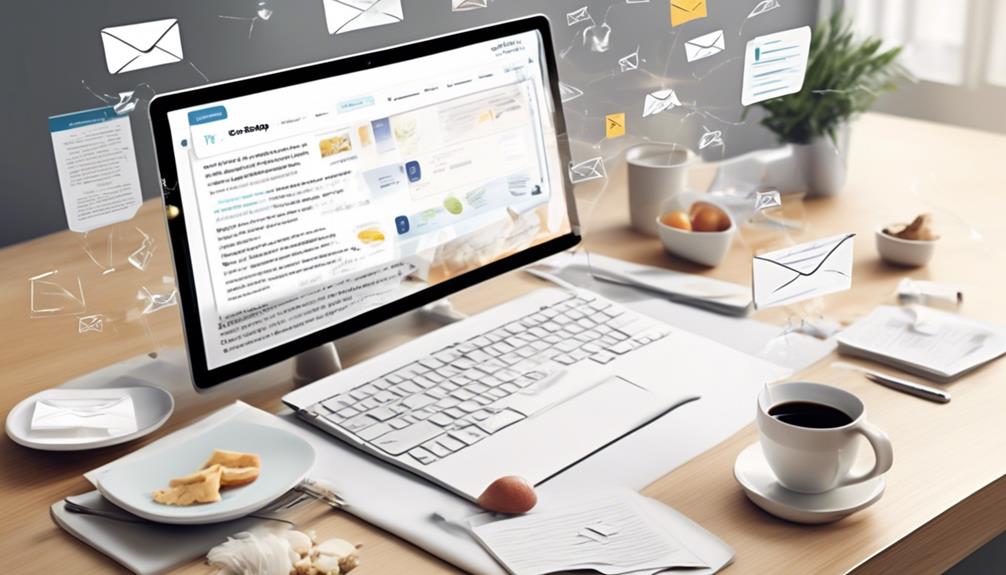
When implementing inbound email marketing, businesses can effectively engage consumers by delivering relevant and tailored content directly to their inboxes. This approach aligns with the interests and preferences of the recipients, making it more likely for them to engage with the brand.
Here are three examples of inbound email marketing:
- Newsletters: These emails provide subscribers with valuable information, updates, and insights related to the brand's products or industry. By offering meaningful content, newsletters keep the brand top-of-mind and nurture long-term relationships with the audience.
- Welcome Emails: These are sent to new subscribers or customers, expressing appreciation for their interest and providing them with useful information about the brand, its products, and how to get the most out of their experience. Welcome emails set the tone for a positive brand interaction and can significantly impact the recipient's perception.
- Promotional Emails: While still being promotional, these emails are tailored to the specific interests of the recipients. By leveraging data and analytics, businesses can send targeted promotions to individuals who've shown a genuine interest in their products or services, increasing the likelihood of conversion.
Inbound email marketing allows businesses to establish meaningful connections with people genuinely interested in their brand, fostering brand loyalty and driving sustainable growth.
Outbound Email Examples
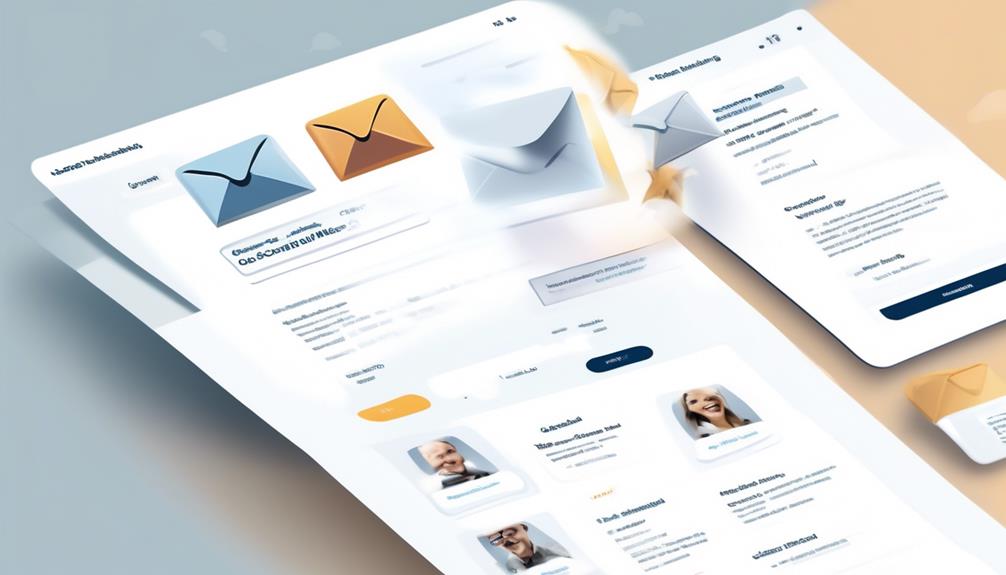
Outbound email examples are a crucial aspect of any marketing strategy. Understanding the purpose and strategy behind outbound emails can greatly impact their effectiveness.
Outbound Email Purpose
To effectively illustrate the purpose and impact of outbound email marketing, consider the example of a personalized email campaign tailored to recent events that resulted in a significant increase in customer engagement and conversions.
- Promotional Reach: Outbound emails serve as a strategic tool for spreading brand awareness and promoting products or services to a broader audience.
- Engagement and Conversion: They aim to spark interest and trigger positive emotions, leading to increased customer engagement and higher conversion rates.
- Cold Outreach: Outbound email marketing strategies involve reaching out to potential leads through personalized and targeted cold emails based on an ideal customer profile.
Outbound Email Strategy
Building on the impactful potential of personalized outbound email campaigns, let's now explore specific examples that demonstrate successful outbound email strategies in action.
A well-crafted outbound email strategy can yield impressive results, with open rates averaging 16.07% and click-through rates reaching 3.29%. Techniques such as AIDA, PAS, BAB, and PPP cold emails can be effectively utilized in outbound email marketing.
While there are costs associated with outbound email marketing, including email service provider fees, tool subscriptions, and content creation, these investments can be justified by the potential for reaching a wider audience.
Building and maintaining targeted contact lists is crucial for sending outbound emails to the right recipients.
Real Business Case Studies
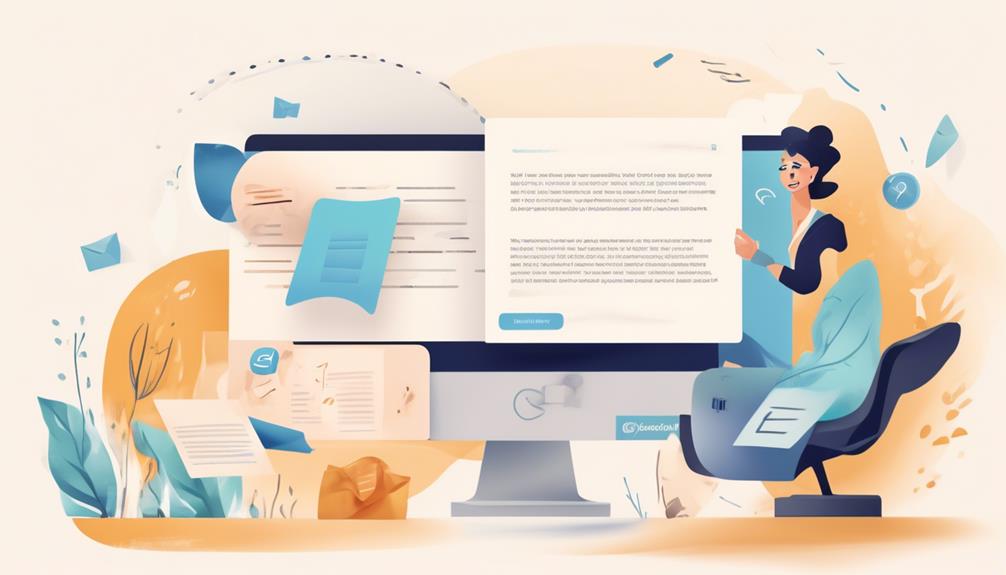
Real Business Case Studies offer invaluable insights into successful business strategies and tactics implemented by various companies, providing practical, real-world examples of business challenges and solutions. These case studies cover a wide range of industries, offering diverse perspectives and learnings. They provide actionable takeaways for business professionals, serving as a platform for learning from the experiences of other businesses and aiding in decision-making and strategy development.
- Diverse Industry Perspectives: Case studies encompass a wide array of industries, including technology, retail, finance, and healthcare, offering insights applicable to different business sectors.
- Practical Solutions and Strategies: Real-world examples showcase how companies effectively utilize inbound and outbound email marketing campaigns, including abandoned cart emails, to drive customer engagement and sales.
- Decision-Making Support: Business case studies provide valuable data and analysis, aiding professionals in making informed decisions regarding their inbound and outbound email marketing strategies.
Real Business Case Studies present an opportunity to delve into the practical applications of inbound and outbound email marketing, providing actionable insights that can be leveraged to enhance email marketing campaigns and achieve business objectives.
Integrating Email Marketing
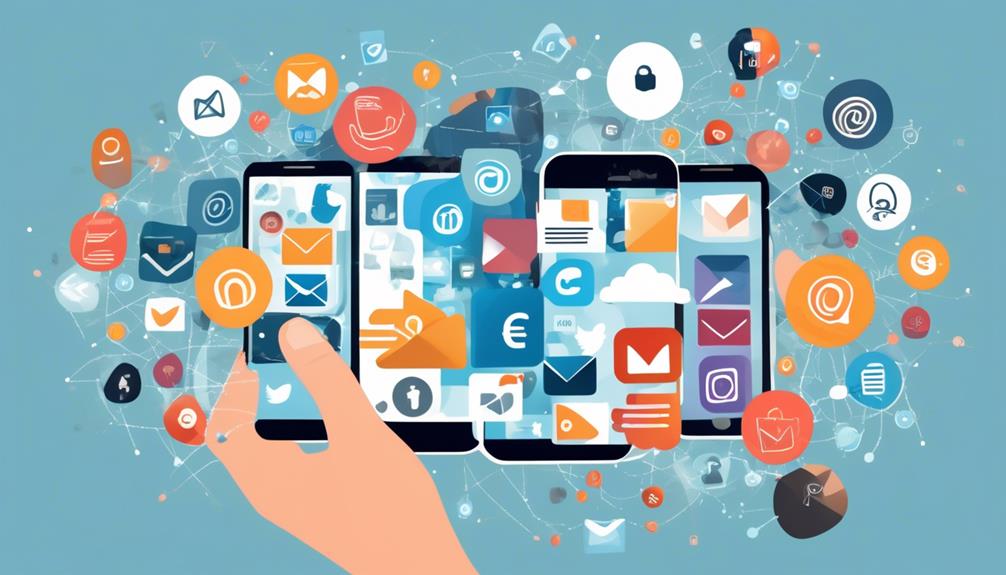
As we explore 'Integrating Email Marketing', we can draw practical insights from real business case studies to understand how companies effectively incorporate email marketing into their inbound and outbound strategies to drive customer engagement and achieve business objectives.
Integrating email marketing into the inbound strategy involves nurturing initial consumer interest and providing relevant content to attract them to products and services. This approach increases opt-ins, protects IP address reputation, and tailors marketing to consumer interest, ultimately driving organic brand awareness, building trust, and loyalty. It also includes offering valuable content like blogs, webinars, and newsletters.
On the other hand, integrating email marketing into the outbound strategy allows for reaching a wider audience and expediting results by getting messages to potential customers on a set schedule. It enables strategic targeting of specific audiences while managing costs and avoiding the risk of appearing as spam.
Adding Outbound Strategy

Implementing an outbound email strategy can significantly expand the reach of your marketing efforts and accelerate engagement with potential customers. There are several key reasons why adding an outbound strategy to your email marketing approach can be beneficial:
- Broader Audience Reach: Outbound email marketing allows you to target a wider audience, including individuals who may not have interacted with your brand through inbound channels. This presents an opportunity to build a larger base of potential customers who may be interested in your products and services.
- Expedited Results: Unlike inbound email marketing, which relies on customers initiating contact, outbound strategies enable you to proactively reach out to potential leads. This can expedite the process of generating interest and conversions, allowing you to control the timing of your outreach efforts.
- Enhanced Visibility: By utilizing outbound email marketing, you can increase the visibility of your brand and offerings to a broader audience. This can help spark initial interest and awareness, potentially leading to new customer acquisitions.
Incorporating an outbound email strategy into your overall marketing approach can complement your existing inbound efforts, ultimately contributing to a more comprehensive and effective outreach strategy.
Additional Resources
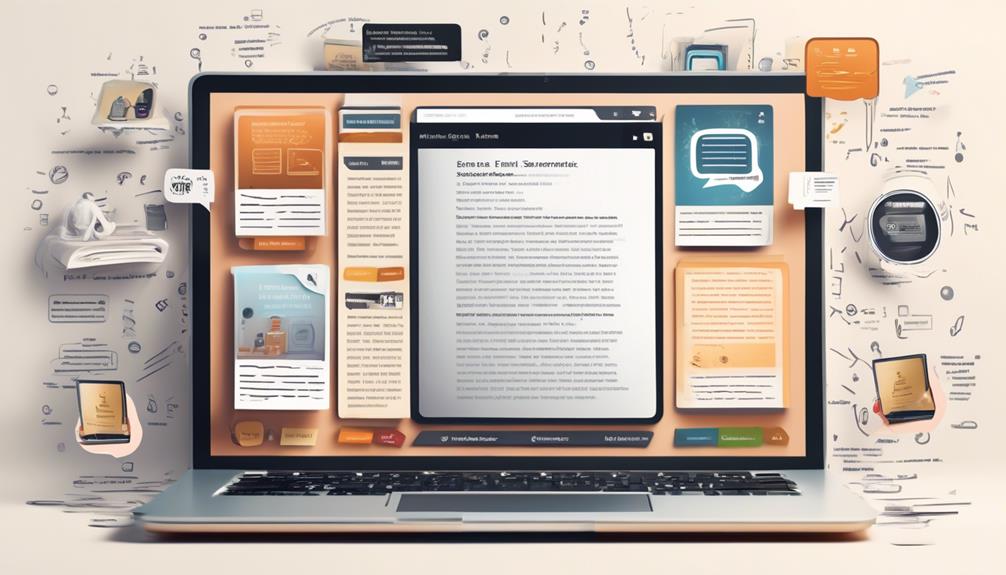
As we continue to explore the intricacies of email marketing, it's imperative to leverage additional resources to elevate our strategies.
These resources offer valuable insights and best practices for enhancing email engagement and conversion rates.
Email Types
How do different email types contribute to the effectiveness of inbound and outbound marketing strategies?
- Welcome emails: These are crucial for inbound marketing as they can nurture initial consumer interest through relevant content and tailored experiences, increasing opt-ins and driving brand awareness organically.
- Cold calls: Typically associated with outbound marketing, cold calls refer to reaching out to potential customers who didn't request the email. While this approach reaches a wider audience, it can be costly and risks appearing as spam.
- Targeted emails to people who've shown interest: These are effective for both inbound and outbound marketing. Inbound email marketing nurtures consumer interest through tailored experiences, while outbound email marketing targets a wider audience and can help reach a wider audience. However, it may be less effective in turning recipients into customers compared to inbound marketing.
Marketing Strategies
Considering the significant impact of different email types on inbound and outbound marketing effectiveness, exploring additional resources for optimizing marketing strategies becomes imperative. When devising a comprehensive marketing approach, it's crucial to consider the integration of email with other channels like social media marketing. Utilizing the AIDA formula (Attention, Interest, Desire, Action) can enhance the effectiveness of outbound email campaigns by guiding recipients through the stages of making a purchase decision. Inbound email marketing can be further optimized by leveraging personalized messages that resonate with the audience's needs and interests. To provide a clear overview, here's a comparison table showcasing the key differences between inbound and outbound email marketing:
| Aspect | Inbound Email Marketing | Outbound Email Marketing |
|---|---|---|
| Target Audience | Warmed-up contacts | Wider audience |
| Cost-effectiveness | Higher ROI due to engaged audience | Effective when used properly |
| Approach | Nurtures captive audience over time | Reaches entire audience, encourages engagement |
| Techniques | Tailored experiences, valuable content | AIDA formula, personalized messages |
Is Email Marketing in Hindi also categorized as Inbound or Outbound?
Yes, email marketing in Hindi can be categorized as both inbound and outbound. In inbound marketing, emails are sent to engage with existing customers, while in outbound marketing, emails are used to reach out to potential customers. Both can be effective strategies for targeting Hindi-speaking audiences.
Frequently Asked Questions
Is Email Marketing Considered Inbound or Outbound?
Email marketing is a powerful tool for engaging with our audience and driving brand awareness. It allows us to tailor our messaging to consumer interests, saving money and increasing opt-ins.
What Is an Outbound Email Marketing?
Outbound email marketing involves proactively reaching out to potential customers who haven't opted in. It's a strategic approach to target specific audiences and drive quick results on our schedule.
While it can expedite messaging to a wider audience, it risks being perceived as spam and can be costly. Successful outbound email campaigns can achieve open rates of 16.07% and click-through rates of 3.29%, making it a powerful but challenging tactic to master.
What Type of Marketing Is Email Marketing?
Email marketing encompasses both inbound and outbound strategies. Our approach is to tailor the content and engagement to the audience's level of familiarity with our brand.
We prioritize nurturing existing interest and building loyalty through valuable content and tailored experiences. This data-driven strategy helps us attract and engage a loyal audience.
What Is Email Inbound and Outbound?
Inbound email marketing focuses on nurturing consumer interest with valuable content, driving brand trust and loyalty. It increases opt-ins, protects IP reputation, and tailors marketing to consumer interests.
On the other hand, outbound email marketing involves sending advertising to a broad audience, risking appearing as spam. Inbound marketing pulls in interested consumers, produces results over time, and garners a more loyal audience through engagement, while outbound marketing targets a wider audience, produces immediate results, and often leads to more unsubscribers.
Conclusion
In conclusion, whether email marketing is inbound or outbound really depends on your perspective. But let's be real, we all know it's just a fancy way of saying 'spam' or 'valuable content.'
So why not just focus on creating valuable, relevant content that people actually want to engage with? It's not rocket science, it's just good marketing.
Let's leave the spam in the can where it belongs.
Bryn – AI Expert Writer Bryn is the wizard of words and AI at Influenctor. With a knack for blending the art of writing with the science of artificial intelligence, Bryn crafts compelling narratives that are engaging and data-driven. Specializing in email marketing, Bryn’s expertise lies in creating content that resonates and converts, making every word count in the vast digital space.
Personalized Email Strategies
Email Marketing for Magento
Foster direct customer connections and drive sales with powerful email marketing strategies for Magento – discover the key to unleashing its potential.

In the journey through the digital terrain of eCommerce, imagine a pathway that enables direct interaction with your customers, enticing them to return to your Magento store through captivating content and tailored promotions.
Email marketing for Magento holds the key to unlocking this potential, but how do we harness its power effectively?
From audience segmentation to automation strategies, and maximizing revenue, the world of email marketing for Magento is vast and filled with opportunities waiting to be explored.
Join us as we uncover the essential strategies and tactics that can elevate your eCommerce business to new heights.
Key Takeaways
- Consistently engage customers through personalized and automated email sequences
- Utilize Magento email marketing extensions and templates tailored for Magento
- Leverage the Remarkety plugin for targeted email campaigns, including Abandoned Cart and Follow Up Email sequences
- Integrate Magento with leading email marketing platforms such as Moosend, HubSpot, and Campaign Monitor
Magento Email Marketing Strategies
When implementing Magento Email Marketing Strategies, it’s crucial to consistently engage with customers through personalized and automated email sequences. Utilizing email marketing extensions and templates tailored for Magento can significantly enhance customer engagement and drive sales.
One effective approach is leveraging the Remarkety plugin for Magento, a robust marketing automation tool that enables the creation of targeted email campaigns, including Abandoned Cart and Follow Up Email sequences. These tailored emails can efficiently re-engage customers who’ve shown interest in products but didn’t complete the purchase, thereby reducing cart abandonment rates.
By integrating Magento with leading email marketing platforms such as Moosend, HubSpot, and Campaign Monitor, businesses can achieve personalized and automated email strategies that resonate with their target audience. This integration not only streamlines the process but also allows for data-driven insights to further optimize the effectiveness of email marketing campaigns.
Ultimately, mastering Magento email marketing strategies empowers businesses to maximize the potential of ecommerce marketing, driving higher website traffic, customer engagement, and sales revenue.
Audience Segmentation Tips

To effectively harness the power of Magento email marketing strategies, audience segmentation tips play a pivotal role in delivering tailored and relevant content to different customer segments based on demographics, behavior, and preferences.
When creating personalized emails, consider the following audience segmentation tips:
- Utilize customer data to segment your audience based on demographics, behavior, and preferences for targeted and relevant content.
- Segment your audience by purchase history, browsing behavior, and engagement with your emails to send tailored emails for special occasions, promotions, and product recommendations.
- Employ segmentation to categorize customers based on their interaction with your website, such as first-time visitors, frequent shoppers, or dormant users, for targeted re-engagement campaigns.
- Segment your audience by geographic location, time zone, and language for localized and timely communication.
Compelling Content Creation
Compelling content creation is the cornerstone of successful email marketing campaigns, driving engagement and retention among subscribers. In the context of email marketing for Magento, compelling content is essential for maximizing the impact of marketing efforts. To achieve this, it’s crucial to create personalized and relevant content that resonates with the recipients. Leveraging the Drag-and-Drop email editor in Magento can streamline the process of crafting visually appealing emails that effectively convey compelling content.
Automating emails, such as abandonment emails, presents an opportunity to add all product items that the customer left behind, accompanied by compelling content that may entice them to complete the purchase. This approach not only helps in boosting sales but also contributes to improving open rates by delivering valuable and personalized content.
Moreover, compelling content should go beyond simply promoting products. It should aim to provide value to the subscribers, whether through informative articles, customer testimonials, or storytelling. By consistently delivering compelling content, brands can establish credibility and build long-term relationships with their audience, ultimately contributing to the success of their email marketing endeavors.
Automation for Conversions

In email marketing for Magento, implementing automation for conversions streamlines the process of turning leads into customers by using targeted and personalized email sequences. This approach involves leveraging automation tools to deliver the right message at the right time, significantly increasing the effectiveness of email marketing efforts.
Here’s how automation for conversions in email marketing can benefit Magento stores:
- Nurturing Leads: Automation allows for the creation of dynamic and behavior-triggered email campaigns, nurturing leads through the sales funnel and increasing the likelihood of turning them into paying customers.
- Improved Customer Engagement: By implementing automation for conversions, businesses can achieve higher conversion rates and improved customer engagement through personalized and timely communication.
- Time and Resource Savings: Automation helps save time and resources by automating repetitive tasks and optimizing the conversion process, allowing businesses to focus on other critical aspects of marketing for Magento.
- Increased Average Order Value and Customer Lifetime Value: Targeted automation can lead to increased average order value and customer lifetime value by delivering relevant and personalized content to customers.
When marketing for Magento goes hand in hand with automation for conversions, businesses can integrate email marketing platforms seamlessly, utilize SMS marketing, and create effective welcome email sequences to drive conversions. Leveraging the capabilities of automation for conversions can be a game-changer for Magento stores, leading to improved results and customer relationships.
Revenue Maximization Techniques
Implementing upselling strategies through personalized email marketing is a key technique for driving increased revenue in Magento stores. By utilizing email automation and personalized recommendations, store owners can reactivate inactive customers and boost sales.
Integrating Magento with email marketing platforms enhances customer loyalty and drives website traffic. Leveraging segmentation and targeting options in email marketing extensions increases customer engagement and improves conversion rates.
Advanced email analytics and personalized email templates track results, improve ROI, and drive effective email campaigns. To maximize revenue, it’s crucial to address the cart abandonment rate through a well-crafted email strategy.
Additionally, optimizing emails for mobile devices ensures a seamless shopping experience, ultimately increasing the lifetime value of customers.
Frequently Asked Questions
How Does Magento Send Emails?
We send emails in Magento through its built-in email functionality, utilizing PHP’s mail function or SMTP for flexibility in configuration. It can also be configured to use third-party email service providers like SendGrid or Mailgun for improved deliverability and analytics.
Managing email sending settings within the Magento admin panel allows for easy customization of email templates and content. Additionally, we can enhance email sending in Magento through extensions and plugins for advanced features like email tracking, personalization, and automation.
Does Email Marketing Work for Ecommerce?
Oh, email marketing for eCommerce? It’s just a game-changer! We’ve seen remarkable results with increased sales, brand awareness, and customer engagement.
Personalization and segmentation tools have allowed us to tailor our campaigns, reducing cart abandonment and driving traffic to our website.
The integration with CRM systems and the availability of automated campaigns and customizable templates have really stepped up our game.
It’s been a true game-changer for our eCommerce success.
Which Email Is Best for Email Marketing?
We find that the best type of email for email marketing depends on the specific goals and target audience. For general promotions, newsletters and product announcements work well.
For customer retention, personalized follow-up emails and cart abandonment reminders are effective.
A/B testing different types of emails can also help determine the best approach for a particular business.
How to Use SMTP in Magento 2?
Sure, we use SMTP in Magento 2 by configuring the SMTP settings in the admin panel. After that, we enter the host, port, authentication method, username, and password for the SMTP server. This ensures secure and reliable email delivery.
We can also enable logging and debug mode for testing. Setting up SMTP in Magento 2 improves deliverability and reduces the likelihood of emails being marked as spam.
Conclusion
In conclusion, email marketing for Magento is a powerful tool for eCommerce success.
By implementing the strategies and tips mentioned, businesses can engage with their audience, create compelling content, and maximize revenue through automation.
Just like how a well-oiled machine operates seamlessly, a well-executed email marketing strategy can drive results and improve the overall success of an eCommerce business.
Natali – Editor in Chief (Strategy and Mastery, AI Expert) Natali, our Editor in Chief, is the driving force behind our content’s strategic direction. With a keen eye for detail and a deep understanding of market trends, Natali ensures that our content is top-notch and strategically aligned with our client’s goals. Her expertise in AI helps to seamlessly integrate advanced technology into our marketing strategies, pushing the boundaries of conventional marketing.
Personalized Email Strategies
Email Marketing for Automotive Dealers
Often overlooked, email marketing holds the key to unlocking untapped potential for automotive dealers – find out how it can revolutionize your dealership's success.

In the context of marketing strategies for car dealerships, something you may not be aware of is the significant impact that email marketing can possess in boosting sales and captivating the interest of customers.
The potential for reaching a targeted audience and building lasting relationships with customers through personalized messages is often underestimated.
But there’s more to it than meets the eye.
As we explore the strategies and best practices for email marketing in the automotive industry, you’ll discover how it can be a game-changer for your dealership’s success.
Key Takeaways
- Personalized communication through email marketing helps build a stronger connection with customers, leading to better engagement and increased sales.
- Building an email list through opt-in forms, incentives, social media, and events is crucial for effective email marketing.
- Different types of email campaigns, such as welcome emails, promotional emails, surveys, service reminders, and tech updates, serve different purposes in nurturing customer relationships and driving sales.
- Utilizing AI in email marketing can enhance personalization, gather valuable insights, create visually appealing emails, and maximize marketing efforts.
Why Email Marketing Works for Car Dealerships
Email marketing works for car dealerships because it allows us to personalize communication with customers, fostering a more intimate connection and driving engagement and sales. The automotive industry is highly competitive, and establishing a personal connection with customers is crucial. Through targeted email marketing campaigns, we can tailor our communication to the specific needs and interests of our customers. This personalized approach not only increases the likelihood of our emails being well-received but also encourages customers to take action, ultimately driving sales and generating leads.
Customers appreciate the convenience and relevance of dealership emails. By delivering valuable information about new car models, special promotions, and service reminders, we can engage customers and keep our brand top-of-mind. This direct line of communication allows us to extend customer journeys, nurturing relationships beyond the initial sale and encouraging repeat business. Moreover, the cost-effectiveness of email marketing enables us to reach a wide audience while maintaining brand awareness and maximizing our marketing budget.
In essence, email marketing empowers us to connect with customers on a more personal level, drive engagement, and ultimately boost sales within the automotive industry.
Building Your Email List

When aiming to expand your email list, implementing opt-in forms on your website can gradually grow your list with engaged subscribers. Offering incentives such as discounts or exclusive content can encourage visitors to sign up for your email list. This not only helps in building your email list but also in nurturing potential customer relationships.
Utilize social media and events to promote sign-ups and grow your email list organically. This allows you to reach a wider audience and attract new subscribers who are genuinely interested in your dealership.
Data segmentation is crucial in ensuring that your email campaigns are targeted and relevant. By segmenting your email list based on customer interests and behaviors, you can personalize your content and increase engagement.
Regularly cleaning and updating your email list is essential to maintain high deliverability and engagement rates. This ensures that your emails reach the right audience and helps you to effectively manage your email marketing efforts.
Types of Email Campaigns for Dealerships
After successfully building our email list through opt-in forms and engaging incentives, it’s essential to explore the various types of email campaigns that can effectively connect with our customers and drive engagement.
As a dealership, we can send different types of emails to cater to the diverse needs and interests of our customers.
Welcome emails are crucial in creating a great first impression for new subscribers, providing them with a warm introduction to our dealership.
Promotional emails featuring new models, reduced prices, and special offers can entice potential buyers and keep existing customers informed about exciting opportunities.
Online surveys enable us to gain vital insight into customer beliefs and preferences, allowing us to tailor our services accordingly.
Additionally, sending service reminder emails not only keeps our brand top-of-mind but also shows that we care about our customers’ vehicle maintenance.
Lastly, providing tech updates and recall information through emails ensures that our customers are informed about important developments regarding their vehicles.
Effective Email Marketing Tips

Crafting compelling subject lines is crucial to increasing open rates and driving engagement with customers. A catchy subject line can entice recipients to open the email and discover the content inside.
Personalizing content is another key aspect of effective email marketing. By tailoring messages to individual recipients based on their preferences and behaviors, automotive dealers can create a more impactful connection with their customers.
Segmenting the email list is also essential for targeted and effective campaigns. By categorizing recipients based on demographics, purchase history, or engagement level, dealers can send more relevant and personalized content, increasing the likelihood of conversions.
Utilizing analytics to measure and analyze the success of email campaigns is crucial for refining the email marketing strategy. By tracking open rates, click-through rates, and conversions, dealers can gain insights into what resonates with their audience and adjust their approach accordingly.
Lastly, optimizing emails for mobile devices is vital to reach a wider audience, as many consumers engage with emails on their smartphones.
Maximizing EmAIl Marketing With AI
Maximizing our email marketing efforts with AI has proven to significantly elevate customer engagement and drive impressive open rates, surpassing the industry average.
By using AI in email marketing, we can tailor our content to each individual’s preferences, ensuring that our messages are relevant and impactful. This level of personalization not only increases open rates but also makes the customer feel understood and valued.
In the automotive industry, where competition is fierce, AI-powered email marketing can give us a significant edge. AI technology allows us to design surveys that gather valuable insights into customer preferences, enabling us to create targeted and hyper-relevant content.
Additionally, AI can help us create mobile-responsive and visually appealing emails that catch the eye of potential customers, driving sales and customer loyalty. With AI, we can craft attention-grabbing templates and compelling subject lines that increase customer interaction and drive action.
It’s clear that AI is revolutionizing email marketing, and by leveraging its power, we can maximize our marketing efforts and achieve remarkable results.
Frequently Asked Questions
What Is a Good Email Address for Marketing?
A good email address for marketing should be professional, easy to remember, and consistent with the brand. It needs to clearly reflect the dealership’s name and purpose, like sales@dealershipname.com. This makes it convenient for customers and builds brand recognition.
Additionally, it should be easily accessible and visible on the dealership’s website and marketing materials for customer inquiries. These qualities will help enhance the effectiveness of our email marketing efforts.
How Do Car Salesmen Attract More Customers?
We attract more customers by understanding their needs and creating personalized experiences.
We engage them with compelling content, mobile-friendly design, and effective segmentation.
By leveraging video content and email automation, we can build impactful connections and boost engagement.
Our goal is to generate high response rates and encourage customer action, leading to increased loyalty.
We strive to create valuable interactions that resonate with potential customers, ultimately driving more sales.
How Can I Increase Traffic to My Car Dealership?
To increase traffic to our car dealership, we implement targeted email campaigns to reach specific audiences and increase engagement. We utilize personalized messages to create a more impactful connection with potential customers. This strategy drives traffic to our website and generates leads.
How to Do Marketing for Car Sales?
We attract customers through targeted ads, compelling content, and personalized offers.
Our approach focuses on building relationships, providing value, and addressing customer needs.
By leveraging data and analytics, we tailor our marketing efforts to specific customer segments, maximizing our impact and ROI.
We also prioritize customer engagement, leveraging social media and community events to foster connections and loyalty.
Our strategy ensures that our marketing efforts are relevant, impactful, and drive sales.
Conclusion
In conclusion, email marketing is a powerful tool for automotive dealers to connect with customers and drive sales.
Through personalized messages and targeted campaigns, dealerships can build customer engagement and loyalty while generating leads and website traffic.
With the use of analytics and AI, email marketing can be maximized for success.
It’s not just a theory, it’s a proven strategy for automotive dealers to effectively reach and connect with their customers.
Natali – Editor in Chief (Strategy and Mastery, AI Expert) Natali, our Editor in Chief, is the driving force behind our content’s strategic direction. With a keen eye for detail and a deep understanding of market trends, Natali ensures that our content is top-notch and strategically aligned with our client’s goals. Her expertise in AI helps to seamlessly integrate advanced technology into our marketing strategies, pushing the boundaries of conventional marketing.
Personalized Email Strategies
Email Marketing for Banks
Power up your bank's email marketing with innovative strategies that drive engagement and create meaningful connections.

Email marketing is a potent and effective instrument for banks to forge stronger relationships with customers and create appealing campaigns. However, the question remains: how can banks guarantee their email marketing initiatives shine amidst a cluttered inbox? Given the ongoing advancements in digital communication, it is essential for banks to embrace creative approaches that capture interest and encourage participation.
So, what are the key elements that banks should consider to maximize the impact of their email marketing initiatives? Let’s explore how banks can leverage segmentation, personalization, and compelling content to elevate their email marketing game and create meaningful interactions with their customers.
Key Takeaways
- Compliance with GDPR, CAN-SPAM, and CCPA regulations is crucial for email marketing in the banking industry.
- Personalization and segmentation are essential for targeting customers at different stages of the buyer’s journey and improving engagement.
- Providing clear unsubscribe options and adhering to legal requirements in email design and footer information is necessary.
- Banks can use email campaigns to educate customers, establish trust, drive engagement with special deals, and guide customers through the buyer’s journey.
Email Marketing Legal Compliance
In ensuring legal compliance for email marketing in the financial services industry, it’s imperative to adhere to the strict requirements set forth by GDPR in Europe and the CAN-SPAM and CCPA acts in the U.S. Compliance with these laws is crucial for financial services companies to maintain credibility and protect consumer data privacy.
When crafting email marketing campaigns for financial institutions, it’s essential to incorporate the necessary measures to ensure legal compliance. This includes implementing a robust email marketing strategy that aligns with the guidelines outlined in these acts.
To adhere to legal requirements, financial email marketing initiatives need to incorporate dedicated checkboxes for subscribers to choose their preferences, ensuring that explicit consent is obtained for each specific purpose of collecting emails. Additionally, including a clear unsubscribe button and promptly removing contacts who opt out from the email list is vital to comply with legal standards.
Furthermore, financial services companies must provide required information, such as data processing details and a valid postal address, in the email footer and on their website to maintain legal credibility.
In this digital age, where data privacy is paramount, ensuring legal compliance through measures like two-factor authentication and transparent data processing practices isn’t only a legal obligation but also a means to build and maintain trust with clients.
Email Best Practices for Banks

As we embrace the email best practices for banks, it’s essential to seamlessly integrate legal compliance measures, such as GDPR, CAN-SPAM, and CCPA, into our marketing strategies to ensure customer trust and data privacy.
Personalizing emails is crucial to target customers at different stages of the buyer’s journey, increasing engagement and conversion rates. Maintaining consistency with our brand image and providing clear unsubscribe options in our email design is non-negotiable.
To effectively reach our diverse customer base, we should use simplified language and segment the audience by age for our email copy.
Moreover, choosing a reliable email service provider is paramount. We need a platform that offers features like automation, segmentation, and personalization capabilities to streamline our email marketing efforts. This ensures that our content is tailored to the specific needs and preferences of our customers.
Segmentation & Personalization
Implementing segmentation and personalization in our email marketing allows us to tailor content to the specific needs and preferences of our customers, leading to higher engagement and conversion rates. By leveraging targeted and dynamic content, we can create a more personalized customer experience, ultimately driving better results for our bank. In the table below, we outline the key benefits of segmentation and personalization in email marketing for banks and financial services.
| Benefits of Segmentation & Personalization |
|---|
| Enhanced Customer Engagement |
| Improved Customer Experience |
| Higher Conversion Rates |
Segmentation and personalization enable us to send relevant content to the right audience, ensuring that our customers receive information that is tailored to their individual financial needs. This not only fosters better engagement but also improves the overall customer experience. By leveraging marketing automation, we can further enhance our segmentation and personalization efforts, ensuring that our email campaigns are not only targeted but also timely and highly relevant. As a result, our bank can achieve higher conversion rates and build stronger, more meaningful relationships with our customers.
Email Campaign Ideas for Banks

By leveraging targeted email marketing strategies, we can effectively reach and engage customers at various stages of their financial journey, ultimately maximizing conversions and fostering stronger relationships.
For banks, email campaigns serve as a powerful tool to educate customers about financial products, establish trust, and position the bank as a trusted advisor. A welcome email, for instance, provides an excellent opportunity to create a positive first impression, introduce services, and encourage customer engagement from the outset. These emails should be personalized, addressing individual needs and preferences to enhance customer loyalty and retention.
Additionally, promotional emails offering special deals and incentives can drive customer engagement and increase sales. Furthermore, lead nurturing through informative content and relevant financial email examples can guide customers through the buyer’s journey, ultimately leading to increased conversions. Each email should include a clear call to action, guiding recipients on the next steps to take.
In the competitive landscape of marketing for financial services, a well-crafted email campaign can significantly impact customer relationships and sales.
Choosing a Reliable Email Service Provider

When selecting a reliable Email Service Provider for banks and financial services, it’s crucial to prioritize factors such as reputation, reliability, and the availability of essential features. For financial companies, the stakes are high due to the sensitive nature of the information being communicated.
Therefore, when considering email marketing, financial advisors and institutions must ensure that the chosen provider offers top-notch security, high deliverability rates, and robust spam filters to protect both the institution and its clients. Additionally, automation, segmentation, and personalization capabilities are crucial for tailoring communications to the specific needs of different customer segments.
Transactional emails, such as those for account statements or online banking alerts, require timely and reliable delivery, making it essential for financial institutions to choose a provider with a proven track record in this area. Furthermore, the ability to send automated emails for financial news updates, loyalty program communications, and promotional offers is essential for effective digital marketing.
When evaluating potential providers, it’s also important to compare pricing plans to ensure they align with the budget and needs of the financial institution. Seeking recommendations and reviews from other financial service providers can provide valuable insights into the experiences of similar institutions with different email service providers.
Frequently Asked Questions
What Type of Marketing Is Used in the Bank?
We use various types of marketing in the bank, such as digital, content, and social media marketing.
Each type serves different purposes, such as attracting new customers, engaging existing ones, and promoting our products and services.
How Do Banks Market to Customers?
We market to customers by leveraging targeted and personalized messages, enhancing experiences. Our strategies involve automation of sales cycles, onboarding, education, and lead nurturing, making it a cost-effective communication channel.
Efficient customer data management and CRM integration enable us to deliver personalized emails. Consistent communication is crucial, increasing engagement, satisfaction, and customer retention.
Personalized customer experiences make financial topics exciting, easily accessible, and secure.
How Do Banks Attract New Customers?
We attract new customers through targeted and personalized marketing efforts. By tailoring our offers to match individuals’ needs and life stages, we engage potential customers about our products and services.
Referral programs and advocacy campaigns help us acquire new customers and enhance our brand image.
Our personalized approach allows us to automate sales cycles and nurture leads effectively, saving time and money in the process.
Which Email Is Best for Email Marketing?
We find that personalized and targeted emails work best for email marketing. They cater to individual preferences and data, boosting engagement and customer satisfaction. Automation of sales cycles and nurturing leads also proves effective. Providing valuable content and balancing customer service with marketing are crucial.
Conclusion
In conclusion, email marketing is a powerful tool for banks to engage and educate customers while promoting their services.
By adhering to legal compliance, implementing best practices, and utilizing segmentation and personalization, banks can effectively reach their target audience.
Additionally, choosing a reliable email service provider is crucial for ensuring successful email campaigns.
Through email marketing, banks can build trust, provide valuable information, and offer special deals to retain customers and attract new ones.
Natali – Editor in Chief (Strategy and Mastery, AI Expert) Natali, our Editor in Chief, is the driving force behind our content’s strategic direction. With a keen eye for detail and a deep understanding of market trends, Natali ensures that our content is top-notch and strategically aligned with our client’s goals. Her expertise in AI helps to seamlessly integrate advanced technology into our marketing strategies, pushing the boundaries of conventional marketing.
-

 Email Automation3 weeks ago
Email Automation3 weeks agoAutomated Email Marketing 101: A Beginner's Tutorial
-

 Email Warmup1 month ago
Email Warmup1 month agoWarm Follow-Up Email
-

 Email Design Hub1 month ago
Email Design Hub1 month ago3 Essential Tools for Email Marketing Design Success
-

 Email Marketing3 weeks ago
Email Marketing3 weeks agoWhat Is Email Marketing Advantages and Disadvantages
-

 Email Marketing4 weeks ago
Email Marketing4 weeks agoWhy Email Marketing Is Effective
-

 Email Template3 weeks ago
Email Template3 weeks agoCrafting the Perfect Book Club Invitation Email Template
-

 Search Engine Optimization3 weeks ago
Search Engine Optimization3 weeks agoSEO Checklist: Enhance Your Site’s Performance
-

 Email Marketing3 weeks ago
Email Marketing3 weeks agoDoes Email Marketing Work in 2024

















